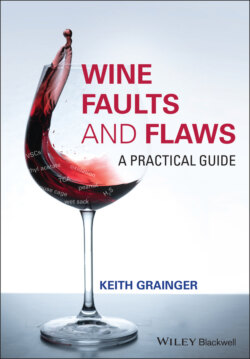Читать книгу Wine Faults and Flaws - Keith Grainger - Страница 56
2.5.4.1 White Wines
ОглавлениеWhite wines can vary in colour from almost water clear to deep gold or even amber. Words used to describe colour might also include green, lemon, straw, and (almost always a signal of alarm) brown. Some white varieties such as Sauvignon Blanc generally produce wines at the green‐lemon end of the colour range. In contrast, others such as Gewürztraminer (which has a more heavily pigmented skin) usually give straw or gold colours. Whites from cooler climates often appear lemon‐green or lemon, and those from warmer areas may veer towards gold. Sweet wines such as Sauternes are usually gold, even in youth, and will deepen, perhaps even to copper with age. The colour of all whites will darken with time. The rate at which this takes place varies considerably depending on several factors, particularly pH and acidity (higher acidity slows down the process) and how well the bottle has been stored. Brown colours are certainly a warning sign of faults, either lightstrike or severe oxidation. Lightstrike, discussed in Chapter 6, is most likely in white wines that have been bottled in clear glass or pale glass and exposed to ultra‐violet light sources.
Of course, the taster will be aware that many wines made from white grapes are deliberately oxidised during the production process, e.g. Amontillado and Oloroso Sherries, and the tuilé and rancio wines from Rivesaltes in the Roussillon region of France. Oxidation, as a fault, is discussed in Chapter 5.
